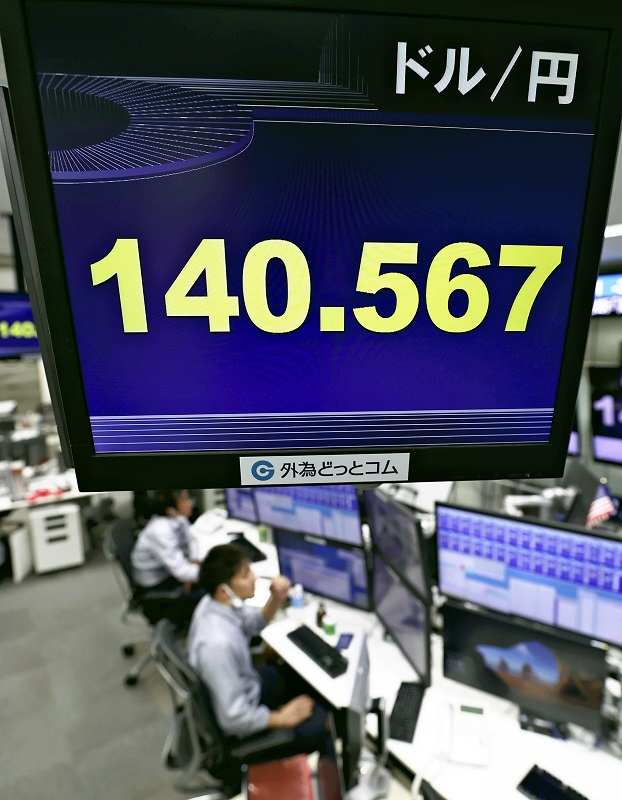Govt and BOJ intervene in currency exchange, effectiveness of trump card is uncertain

A board showing ¥140 per dollar at Gaitame.com Co. in Minato-Ward, Tokyo, Thursday night.
17:37 JST, September 23, 2022
The government and the Bank of Japan have intervened in the currency market by buying yen and selling the dollar for the first time in 24 years in a bid to correct the historic depreciation of Japan’s currency against the greenback.
Amid the increasing burden on households and businesses due to rising import prices caused by the weak yen, the central bank and the government have played the one card up their sleeve.
But the possibility speculators will try to test the seriousness of the intervention by selling off yen looms, meaning the battle of nerves between the government, the BOJ, and the market is likely to continue.
On Thursday, at midday, Vice-Minister of Finance for International Affairs Masato Kanda gave a blunt response to a question on the timing of an intervention to contain the sharp fluctuations in the yen against the dollar. “We are on standby,” he said.
Four hours later, the government and the BOJ intervened by buying yen.
The intervention began following a depreciation of about ¥1 after the Federal Reserve announced a decision to raise interest rates significantly and the Bank of Japan announced that it would continue its massive monetary easing program.
Since Fed Chairman Jerome Powell expressed a positive view on raising interest rates in late August, dollar buying has gained momentum in anticipation of a rate hike and the yen has weakened.
The government has been nervous about responding to the yen’s depreciation since the beginning of September. After meeting with Prime Minister Fumio Kishida on Sept. 9, BOJ Gov. Haruhiko Kuroda expressed his concerns to reporters. “Moves of ¥2 or ¥3 a day are drastic changes,” he said.
The government has repeatedly stated it would “take appropriate measures when necessary” in response to sudden fluctuations.
When the BOJ conducted a “rate check” on Sept. 14, asking major banks about the appropriate exchange rate for transactions, the market took this as a sign of preparation to intervene.
In the market, the move was interpreted as “the ultimate verbal warning.” However, a verbal intervention alone was not enough.
From Wednesday to Thursday, when Japan and the U.S. each set monetary policy, the yen weakened significantly in the foreign exchange market.
Obtaining consent from the United States to intervene by buying yen and selling the dollar was thought to be difficult as the United States is prioritizing measures to combat inflation, and a weaker dollar could lead to higher prices in that country.
Meanwhile, the market was aware of the widening interest rate gap between Japan and the United States, and the Japanese government was seen as unlikely to intervene in the foreign exchange market.
Therefore, the timing of the intervention just after a press conference by Kuroda following the BOJ’s monetary policy meeting shocked the market.
“The intervention was a surprise because it came at a time when most of the yen selling by investors was over and trading volume had declined,” said Masahiro Ichikawa, chief market strategist at Sumitomo Mitsui DS Asset Management.
The yen appreciated temporarily to the ¥140 level as a result of the intervention, but it is unclear whether the move will have a lasting effect.
As of the end of August, the government held $1.292 trillion (about ¥190 trillion) in foreign currency reserves. Of this amount, only about ¥20 trillion is in “foreign currency deposits” that can be spent immediately.
Selling U.S. Treasury bonds, which account for the majority of foreign exchange reserves, to increase the resources for intervention could lead to a rise in U.S. interest rates, which would cause further depreciation of the yen.
Most interventions in the past have involved dollar-buying and yen-selling to correct sharp appreciations of the yen, triggered by events such as the Great East Japan Earthquake.
When the previous yen-buying intervention was conducted in April-June 1998, about ¥3 trillion was spent buying yen and selling the dollar, but against the backdrop of an Asian currency crisis, the yen depreciated to the ¥147 level against the dollar.
The focus of the market is now on the scale of foreign exchange intervention to be announced by the Finance Ministry at the end of the month.



